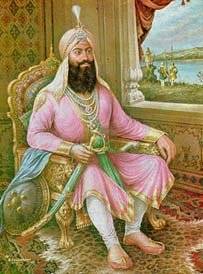
Sardar Jassa Singh Ramgarhia

Jassa Singh Ramgarhia was a born leader of unprecedented qualities. His birth took place near city of Amritsar. He was 5 years old when Banda Singh Bahadur attained martyrdom at Delhi. He was among the crop of those Sikhs who had fought against all odds for survival of their newly founded religion. In those times all Sikhs, cook, ate, fought together and Sikhism was thought of a family. Sardar Kapur Singh was elder and an able leader, Jassa Singh Ramgarhia, Sardar Budh Singh Sandhu (grand father of Ranjit Singh), and others were able leaders fighting Mughals and Afghnis keeping Khalsa flame alive with their resistance. In around 1720's Mughals decided to offer truce to these Sikh leaders and sent some gifts to them in mountains where they were hiding. Mughals offered three towns for Sikhs and title of Nawab for their leader. Five Sikh leaders which includes Budh Singh, Jassa Singh Ramgarhia and others decided to make Kapur Singh Supreme Jathedar of Dal Khalsa and Kapur Singh accepted it only when he was reminded of Guru's order to listen to the anonymous order of Five Gursikhs . Later this group of Sikh leaders created Misals and two factions of Sikhs called Budha Dal and Taruna Dal. Jassa Singh Ahluwalia were youngsters leading their regiments under Taruna Dal and reporting to Jathedar Kapur Singh ji at Diwali and Vasaikhi.
Under Dal Khalsa, Jassa Singh Ramgarhia established his Misl of Ramgarhia in and around riarki area of Amritsar, Gurdaspur and Batala. He also fortified and constructed fort of Ram Rauni at Amritsar. His misal contained more then 5000 cavalry always on move and helping Dal Khalsa whenever Afghanis or Mughals attacked. Sikhs at this time were in control of villages while Mughal administration was only effective in cities. Twenty years Earlier Banda Bahadur had wrecked a havoc on administration by abolishing all taxes and Zamindara system. Now Sikhs only levied "Dasvand", that is 10% of their income for Rakhi tax or "protection tax" for armies.
Mir Mannu became the new governor of Lahore and Multan on the 9th April 1748 A.D. He appointed Kaura Mal as his new Diwan. After setting right the administration of his province, he deployed army patrol to finish the Sikhs of his province. The Sikhs left his territory and moved to other states. Sardar Jassa singh Ramgarhia and his squad joined the army of the Commander of Jalandhar, named Adina Beg. Adina Beg was a cunning treacherous soft and sweet speaking mean person. Adina Beg on one hand would woo Sikhs to join him against Mughals on the other hand he had secret links with Afghanis, while he drew his salary from Mughals. Jassa Singh Ramgarhia, being a simple minded person trusted Adina Beg and joined his army.
The Sikhs gathered at Amritsar on the occasion of Diwali in 1748 A.D. When Mir Mannu came to know of the gathering of Sikhs, he sent his general with an army to blockade Amritsar and sent words to the Commander of Jalandhar, Adina beg to to take his army to help his general in finishing the Sikhs. Adina Beg not telling his Sikh army personnel attacked fort of Ram Rauni. Five hundred Singhs took shelter in fort of Ram Rauni and the rest moved to forests. The combined forces of Lahore and Jalandhar surrounded the fort. Sardar Jassa Singh Ramgarhia was in army who was in siege of fort, with his squad. Plight of his fellow Sikhs sorrounded in the fort of Ram Rauni was too much for him and his squad. One day he deserted the royal army and joined the Singhs inside the fort with his squad. The Singhs inside the fort did not surrender even after two months of siege. Adina Beg felt the departure of the Jassa Singh Ramgarhia in this manner very much but could not do anything. Hearing the news of the second invasion of Abdali, Mir Mannu made peace with Sikhs and sanctioned an estate in Patti area for the livelihood. Thus Jassa Singh Ramgarhia won the battle of Ram Rauni.
Abdali attacked India and Jassa Singh's squad along with other Sikh squad was deployed in and around hills of Jammu, Pathonkot, to harass and snatch Abdali's baggage train. His 5000 cavalry soldiers harassed Abdali's Afghanis through Guerilla tactics of warfare that Abdali lost more soldiers to Sikhs in this type of warfare than his battle with Marthas. Around same time Jassa Singh Ahluwalia freed 2200 young Hindu women from Afghanis who were being taken to the harems and bazaars of Kabul, Baghdad and Basra. It was blessings of Waheguru (the almighty God) that Sikhs who were weak and few had defeated Abdali.
Next year Abdali returned to Punjab only to punish Sikhs. Mughals at this time were under his protectorate and small Mughal chieftains like, Nawab of Sarhind, and Sher Khan, Nawab of Malerkotla as well as other small time nawabs all over Punjab helped Abdali to sorround Sikhs at a place near Malerkotla called Kup. Taruna Dal and Buddha Dal sorrounded Women and children and fought head on for the first time with Abdali and his allies. Sikhs were outnumbered five to one (including women and chlidren on Sikh side). In this battle Sikhs lost about 30-45000 Sikhs in single day of battle and to this day it is called "The greater holocaust"., or "Wadda Ghalughara"
After this incident, Sikhs came out strong and in less than five years Sikhs had defeated all Mughals and Afghani protectorate in between area of River Jamuna and River Indus. Jassa Singh's Ramgarhia Misl had played major part in this struggle. Later Ranjit Singh incorporated Ramgahia Misal into Sarkar Khalsa and thus a one unified Khalsa kingdom was created.
- BACK -